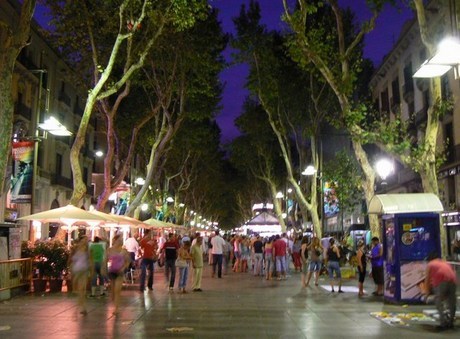Boqueria Market
The Mercat de Sant Josep de la Boqueria, often simply referred to as La Boqueria, is a large public market in the Ciutat Vella district of Barcelona, Catalonia, Spain and one of the city's foremost tourist landmarks, with an entrance from La Rambla, not far from the Liceu, Barcelona's opera house. The market has a very diverse selection of goods.
A visit to the Market of la Boqueria in Barcelona is advisable to enjoy an incredible contrast between colours and activity, ideal to discover why Mediterranean cuisine is internationally known due to its ingredients. The best products from Catalonia in one place: fruit, vegetables, fish and seafood, tapas bars like El Quim and others.
The first mention of the Boqueria market of Barcelona dates to 1217 when tables were installed near the old door of the city to sell meat. From December 1470, a market selling pigs occurred at this site. At this time, the Market had the name Mercat Bornet or was (until 1794) simply known as Mercat de la Palla (Straw Market). In the beginning, the market was not enclosed and did not have an official statute, it was regarded as a simple extension of the market of Plaça Nova which then extended to the Plaça del Pi.
The Boqueria Market, as it is known today, has been through many phases of life. With the following words I'll try to give a faithful description of that rich history as we understand it. Where this market comes from is uncertain, what we are sure of is that it was born as a travelling market, placed in the Ramblas of Barcelona. La Rambla acquired growing importance as a pedestrian lane, and the market was set in the best place to attract the large numbers of passers-by and local inhabitants.
Its location was threatened many times. In Catalonia, towns and cities have been founded around markets and the same rings true for La Boqueria. It originated as an open-air market, in front of one of the gates of the old city wall (Pla de la Boqueria) where fruit and vegetable traders from local towns and farms nearby would sell their products. The spaces inside the city at that time were too small to establish a big market of the current Boqueria kind and it was necessary to set them outside the walls.
Later, the authorities decided to construct a separate market on La Rambla, housing mainly fishmongers and butchers. It is not until 1826 that the market is legally recognized and a convention held in 1835 decides construction of an official place.
The market officially opened the same year, but the plans for the building were modified many times. The official inauguration of the structure was finally made in 1853. In 1911, the new fish market was opened and, in 1914, the metal roof that still exists today was constructed.
Coinciding with the dawn of the 21st century, the market has been reborn in commercial terms, and is now an international name of reference. This is shown by the great number of prizes it has won, which include the prize for the best market in the world, awarded by the World Markets Congress held in 2005 in Washington DC.
At the present time, the market is a member of Emporion, the European Association of Markets offering Excellence in Foods, and has promoted the European Project MedEmporion for the study and implementation of projects within the Mediterranean markets scope. The members of this project are the Barcelona Municipal Markets Institute, representing Barcelona City Council, the cities of Turin, Marseilles and Genoa and the Conservatory of Piamonte.
Another new addition in 2003 is the market’s Culinary Classroom, where children and adults are taught to cook, and different gastronomic events are organised every day.
On entering the market you are met with trays of the most exquisite chocolates and nuts. The hustle and bustle and aromas pervade the air and attack the senses in the most delightful way. Stalls are piled high with strawberries, grapes, melons, figs and many more delicious fruits and vegetables. A gastronomic feast of fruits, vegetables, fish, offal, chicken and meat awaits you. Bags of snails and huge hams suspended in rows hang above the numerous shops.
Every so often you'll catch a glimpe of shimmering tripe and local specialities such as salted cod and sausages. Aromatic cheeses and stalls piled high with the freshest of fruit and colorful aubergines and peppers wet the taste buds and soon you're ready to sample some of these tantalizing foods.
The market is always full of people eagerly enjoying the local dishes and wines of the area and restaurants and bars such as La Gardunya at C/ Jerusalem, 18 Mercat de St. Josep are well worth a visit.
The Mercat de la Boqueria, Barcelona's Central Market, is a great place to belly up to a tapas bar and have lunch. Here is the Bar Central, where you can get a great grilled vegetable platter as well as fish and salads. Barcelona is reputed to have more than half of Spain's vegetarian restaurants and there is no shortage of vegetables here, unlike the rest of Spain. The market is closed on Sunday. You can get there via direct flight to Barcelona or to Girona, Reus or Lleida–Alguaire.



